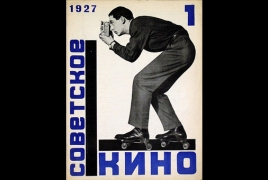Early Soviet photography, film on view at Frist Center for Visual Arts March 11, 2016 - 18:03 AMT PanARMENIAN.Net - The Power of Pictures: Early Soviet Photography and Film, on view at the Frist Center for the Visual Arts from March 11 through July 4, 2016, examines the relationship between art and politics and illustrates how photography, film and poster art were used as powerful propaganda tools in the early years of the Soviet Union. Organized by the Jewish Museum, New York, The Power of Pictures will make its second and final U.S. stop in Nashville before traveling to Europe, Art Daily reports. In conjunction with the exhibition, the film series Revolution and Realism will showcase seminal films from the period. This program, representing a collaboration between the Frist Center, International Lens at Vanderbilt, Belcourt Theatre, and Light + Sound Machine at Third Man Records, will offer screenings at three different locations. From the 1917 Bolshevik Revolution through the 1930s early modernist artists acted as engines of social change and radical political engagement. Through approximately 150 objects, including photographs, 12 feature-length films, periodicals and cameras, The Power of Pictures documents not only how lens-based art was used to disseminate Communist ideology, but also how the compelling, message-laced work from this period energized and expanded the potential of photography and film. The Power of Pictures highlights major constructivist photographers Alexander Rodchenko, El Lissitzky, and Boris Ignatovich, whose work was presented in landmark exhibitions of the time. Such photographers influenced a new generation of photojournalists, including Arkady Shaikhet, Max Penson, Eleazar Langman and Georgy Zelma. The exhibition also includes films by major directors of the era, such as Battleship Potemkin by Sergei Eisenstein and Man with a Movie Camera by Dziga Vertov. In a country where 70% of the population was illiterate, heavily illustrated periodicals and film were considered more effective tools than the written word for the propaganda needs of the Bolsheviks in the 1920s. Recognizing the power of images, Vladimir Lenin himself declared that the camera, as much as the gun, was an important weapon in class struggle and put the arts at the service of the Revolution. Although the Communist government initially encouraged the unconventional techniques of the avant-garde, such as dramatic camera angles and darkroom manipulation, the period of innovation was brief. By 1932, as Joseph Stalin consolidated power, independent styles were no longer tolerated. Artistic organizations were dissolved and replaced by state-run unions. Art was subject to strict state control, and required to promote an approved, idealized socialist agenda. Organized thematically with sections such as “New Perspectives,” “Constructing Socialism,” and “Staging Happiness,” the exhibition demonstrates how alongside avant-garde art, early Soviet photography and film encompassed a much wider range of artistic styles and thematic content than previously recognized. In addition, The Power of Pictures will feature a rich array of vintage film posters, magazines and books. Their striking graphic style, extreme color and dynamic geometric designs, combined with an innovative use of collage and photomontage, convey a sensibility that is fresh and appealing nearly a century later. The exhibition was organized by Susan Tumarkin Goodman, Senior Curator Emerita, and Jens Hoffmann, Deputy Director, Exhibitions and Public Programs, both at the Jewish Museum, New York. “In keeping with the First Center’s goal of encouraging our audience to view the world in new ways through art, this exhibition may inspire visitors to assess the images that we are constantly inundated by today with a more critical and informed eye,” says Frist Center Curator Katie Delmez who is overseeing the Frist Center’s presentation. “The interplay of political messaging and art continues in the ever-evolving media outlets of the twenty-first century.” Photo: Estate of Alexander Rodchenko (A. Rodchenko and V. Stepanova Archive) / RAO, Moscow / VAGA, New York. The creative crew of the Public TV had chosen 13-year-old Malena as a participant of this year's contest. She called on others to also suspend their accounts over the companies’ failure to tackle hate speech. Penderecki was known for his film scores, including for William Friedkin’s “The Exorcist”, Stanley Kubrick’s “The Shining”. The festival made the news public on March 19, saying that “several options are considered in order to preserve its running” Partner news |